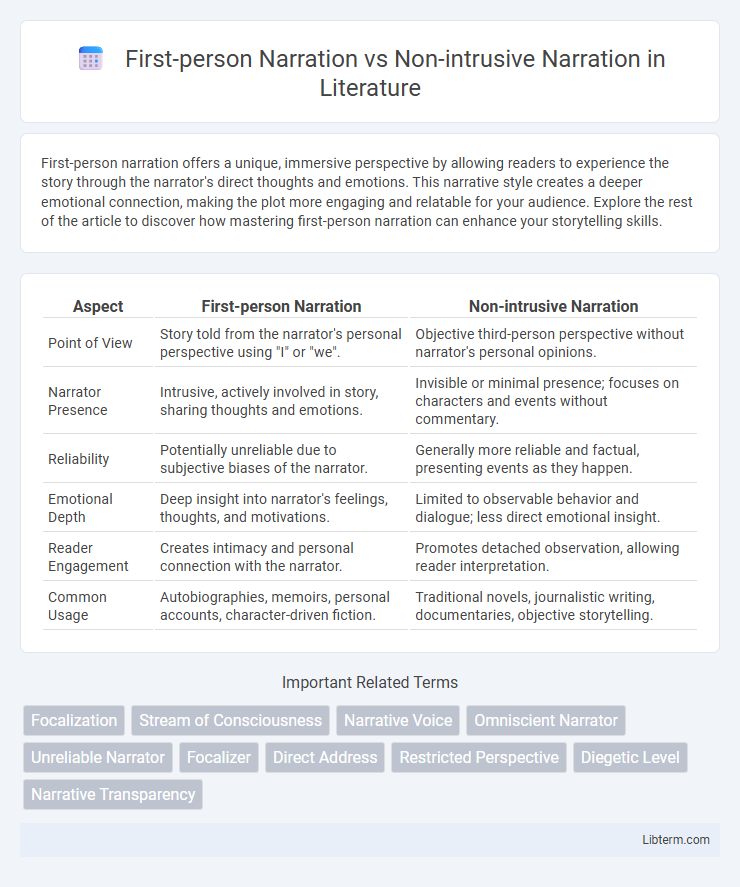First-person narration offers a unique, immersive perspective by allowing readers to experience the story through the narrator's direct thoughts and emotions. This narrative style creates a deeper emotional connection, making the plot more engaging and relatable for your audience. Explore the rest of the article to discover how mastering first-person narration can enhance your storytelling skills.
Table of Comparison
| Aspect | First-person Narration | Non-intrusive Narration |
|---|---|---|
| Point of View | Story told from the narrator's personal perspective using "I" or "we". | Objective third-person perspective without narrator's personal opinions. |
| Narrator Presence | Intrusive, actively involved in story, sharing thoughts and emotions. | Invisible or minimal presence; focuses on characters and events without commentary. |
| Reliability | Potentially unreliable due to subjective biases of the narrator. | Generally more reliable and factual, presenting events as they happen. |
| Emotional Depth | Deep insight into narrator's feelings, thoughts, and motivations. | Limited to observable behavior and dialogue; less direct emotional insight. |
| Reader Engagement | Creates intimacy and personal connection with the narrator. | Promotes detached observation, allowing reader interpretation. |
| Common Usage | Autobiographies, memoirs, personal accounts, character-driven fiction. | Traditional novels, journalistic writing, documentaries, objective storytelling. |
Understanding First-person Narration
First-person narration offers an intimate glimpse into the narrator's thoughts and emotions, enhancing reader engagement through a subjective perspective. This narrative style relies on the use of "I" or "we," creating a personal connection and revealing biases, which shapes the story's authenticity and reliability. Understanding first-person narration is crucial for analyzing character development and the narrative's emotional depth.
Defining Non-intrusive Narration
Non-intrusive narration allows the story to unfold without the narrator's direct presence or personal commentary, maintaining an objective and immersive experience for readers. Unlike first-person narration, which provides intimate access to a single character's thoughts and feelings, non-intrusive narration offers an external viewpoint that reveals actions and dialogues without subjective bias. This narrative style enhances realism and encourages readers to interpret events independently, fostering deeper engagement with the plot.
Key Characteristics of First-person Narration
First-person narration is characterized by its immersive perspective, offering intimate access to the narrator's thoughts, feelings, and personal experiences through the use of "I" or "we." This narrative style allows for subjective interpretation and bias, giving readers a limited but deeply personal view of events. Unlike non-intrusive narration, which maintains an objective distance, first-person narration often includes unreliable insight and emotional engagement that shape the storytelling.
Traits of Non-intrusive Narration
Non-intrusive narration maintains an objective and impartial tone, presenting events without the narrator's personal opinions or emotional involvement, allowing readers to form their own interpretations. It often employs a third-person perspective, focusing on observable actions and dialogues while avoiding direct commentary or judgments. This narration style emphasizes clarity, neutrality, and a seamless flow that immerses readers in the story without overt narrative interference.
Reader Immersion: Personal vs Objective
First-person narration offers a deeply personal perspective, allowing readers to experience the story through the protagonist's thoughts and emotions, which intensifies reader immersion by creating an intimate connection. Non-intrusive narration maintains objectivity by presenting the story from an external viewpoint, enabling readers to form their own interpretations without authorial bias, which fosters a more detached yet comprehensive understanding. The choice between these narration styles significantly impacts reader engagement, balancing emotional involvement with narrative clarity in literary works.
Emotional Impact on Storytelling
First-person narration intensifies emotional impact by providing direct access to the protagonist's thoughts and feelings, fostering deep empathy and personal connection with the reader. Non-intrusive narration, often third-person objective, creates emotional resonance through subtle presentation of actions and dialogue, allowing readers to interpret and engage with the story independently. These narrative choices shape the reader's intimacy with characters and influence the storytelling's emotional depth and authenticity.
Reliability and Perspective Limitations
First-person narration offers a deeply personal and subjective perspective, often limiting reliability due to the narrator's biases, emotions, and incomplete knowledge. Non-intrusive narration, typically third-person omniscient or limited, provides a more objective and comprehensive view, though it may sacrifice the intimate connection found in first-person accounts. Understanding these narrative styles helps readers gauge the credibility of information and the scope of perspective presented.
Narrative Voice and Style Examples
First-person narration offers a deeply personal narrative voice, immersing readers in the protagonist's thoughts and emotions, exemplified by Holden Caulfield in J.D. Salinger's *The Catcher in the Rye*. Non-intrusive narration maintains an objective, detached style as seen in Jane Austen's *Pride and Prejudice*, where the narrator observes events without direct commentary, allowing readers to interpret characters' actions independently. The contrast in narrative voice between these styles shapes reader engagement and emotional connection within the story's structure.
Genre Preferences and Usage
First-person narration is often preferred in genres like memoirs, young adult fiction, and mystery, where personal perspective and emotional depth enhance reader engagement. Non-intrusive narration, commonly used in literary fiction and certain types of science fiction, allows for a broader, more objective portrayal of characters and events without authorial commentary. The choice between these narrative styles significantly impacts reader immersion and genre conventions, influencing how stories are perceived and experienced.
Choosing the Right Narration for Your Story
Choosing the right narration for your story hinges on the desired reader experience and narrative depth. First-person narration offers intimate insights and a direct emotional connection with the protagonist, enhancing immediacy and personal stakes. Non-intrusive narration maintains narrative objectivity, allowing readers to interpret events independently while preserving broader story scope and multiple perspectives.
First-person Narration Infographic

 libterm.com
libterm.com